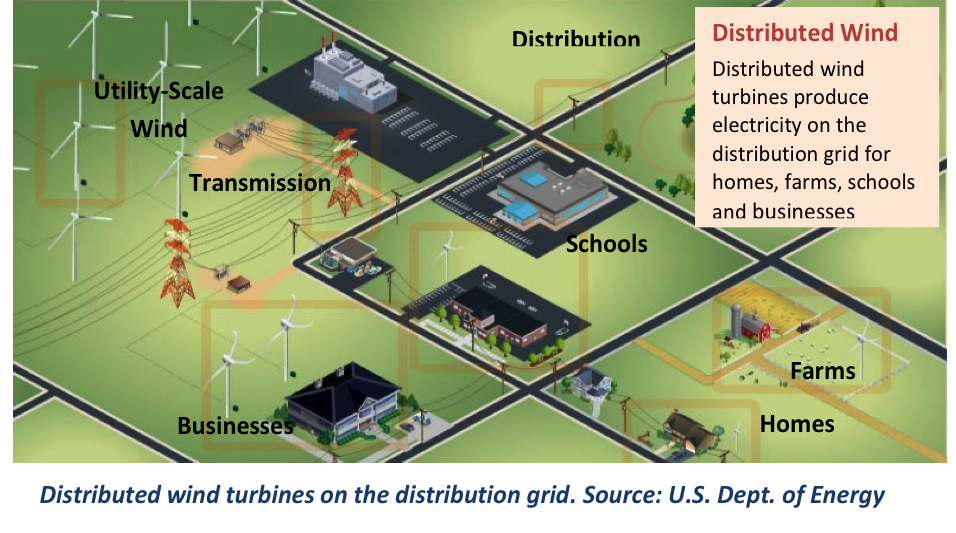Distributed wind (DW) energy systems offer reliable electricity generation in a wide variety of global settings, including households, schools, farms and ranches, businesses, towns, communities and remote locations, as depicted below. Projects range for example from a 1-kilowatt (kW) or smaller off-grid wind turbine at a remote cabin or cell phone tower – to a 10-kW wind turbine at a home, small business, or small agricultural load – to several multi-megawatt (MW) wind turbines at a university campus, manufacturing facility or any large energy user.
DWEA defines Mid-Size DW as projects with one or more of the following: 1) wind turbines with rated capacity of 100 kW and above; or 2) installed in microgrid applications; or 3) interconnected to distributed line voltages of 60 kV or less.

The sheer number of sites with enough space and a productive wind resource is in the tens of millions, giving distributed wind applications the potential to contribute at the gigawatt scale. Installed primarily where people live and work, distributed wind turbines are often the public’s first exposure to wind energy.
Distributed Generation
Distributed generation (DG) refers to electrical power generation that occurs close to where the power is consumed, independent of the type of power-generating technology. Electricity that is primarily used on site by the system owner is often called “inside-the-fence” or “behind-the-meter” generation.
DG systems are typically small by comparison to centralized power plants, but they provide significant benefits including reduced energy loss during transmission and reduced load on utility transmission and distribution lines. In recent years, distributed generation has also become a viable energy alternative regarding national security concerns. Strictly speaking, “distributed wind” refers to any DG wind facility serving local loads.
Defining Distributed Wind Energy
The U.S. Department of Energy (DOE) Energy Efficiency and Renewable Energy (EERE) Wind and Water Power Technologies Office defines distributed wind in terms of technology application based on a wind project’s location relative to end-use and power-distribution infrastructure, rather than by technology size or project size; thus, the distributed wind market includes turbines and projects of many sizes. Wind systems are characterized as distributed based on the following criteria:
- Proximity to end-use: wind turbines installed at or near the point of end-use for the purposes of meeting onsite load or supporting the operation of the local (distribution or micro) grid.
- Point of interconnection: wind turbines connected on the customer side of the electric meter or directly to the local grid.[1]
Distributed wind energy systems are connected either physically or virtually on the customer side of the meter (to serve onsite loads) or directly to the local distribution or micro grid (to support local grid operations or offset nearby loads). This distinction differentiates typically smaller distributed wind systems from power generated at wind farms comprised of dozens or hundreds of multi-MW wind turbines and sent via transmission lines to substations for subsequent distribution to loads.
Wind Turbine Size Designations
The size of wind turbines in distributed applications can vary widely, including:
- Smaller wind turbines commonly up to 50 kW fostering energy independence for households, small farms and ranches, and other consumers and providing local grid support, charging batteries and supplying power at cabins and other off-grid sites, and
- Wind projects up to multiple MW reducing energy costs at or near agricultural, commercial, industrial, and institutional sites and facilities.
Wind turbines up to 100 kW are eligible for the 30% federal Business Energy Investment Tax Credit through 2016. For the purposes of certification, international wind turbine standards apply to:
- “Small” wind turbines having rotor swept areas up to 200 square meters (approximately 50 kW);
- “Medium” wind turbines having rotor swept area between 201-1,000 square meters (approximately 50 kW up to approximately 500 kW).
Ownership and Jobs
A wind project’s ownership does not define whether it is distributed wind; however, distributed wind systems are typically owned by a local entity, for example an individual or family, a school district or hospital, a farm or ranch, a local business, a municipality, or a Tribe, that uses most of the electricity on site.
Most distributed wind projects as well as some wind farms are community-owned incorporating local financial participation and control. Some distributed wind projects and most wind farms are owned by outside professionals, such as energy investors or wind farm developers, and the electricity is sold either under a leasing arrangement to energy consumers or bulk to a utility.
Distributed, locally-owned and community projects typically contribute more to local economic development than conventional wind farms.
DWEA’s Focus
DWEA was formed specifically to support the needs of smaller-scale wind projects with a significant element of local ownership and electricity use. DWEA’s primary mission is to promote and foster all aspects of the American distributed wind energy industry.
[1] The local grid is defined as distribution lines with interconnected electric load(s), typically at a voltage of 34.5 kV or below.
